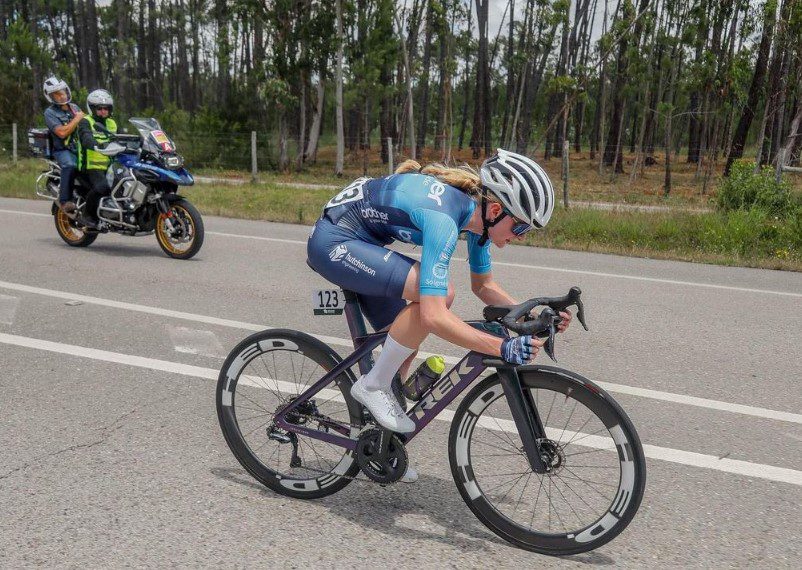Bike Fits – Do you really need one?

In this article, regular contributor, Dannie Watkinson, a UK based British road racer shares her experiences of bike fitting
You may be wondering what a bike fit is, chances are you’ve come across the term and aren’t sure if it’s worth it.
From my opinion a bike-fit is a godsend. Hands down, the best decision I have ever made, although, it takes some getting right.
I’ve now had bike-fits with three different people. The first one did not work for me, and it took me some time before I accepted that.
My first one was with a bike-fitter/physio, in my mind, if I could have a fit with someone skilled in both areas, then they can work with my ailments and wonky body to enhance performance. Yes, in theory that’s great. Even though, every bike-fitter must be qualified, the majority work to a varied range of angles and saddle heights etc.
My first bike-fitter worked to what I would say is the extremes of the ‘ideal’ angles for a cyclist – I assume when in training, they get given the ‘perfect’ model cyclist angles for peak performance gains. Unfortunately, they don’t work for everyone for various reasons. After a year of persevering, I gave into my partner telling me my saddle was too high and causing my saddle sores, and visited another bike-fitter, someone I went to university with.
To tell you it was a game changer would be the biggest understatement of the year. He lowered my saddle 15mm, yes 15!! He moved my hoods further up the bar so I could ‘lock’ my wrists into place for balance – I have a winged scapular and dropped shoulder, so I was stretching so far to my hoods that it was making me roll over my saddle, rather than sit in it and thus causing sores.
Now, I’m not saying my first bike-fitter was wrong, his decisions were perfectly fit for many people, and I know so many people who get on well with his bike fits. Unfortunately, for me I just couldn’t and it’s all about trial and error, which is why, after a bike fit you often have a 6-week check-up – I didn’t go to mine because I was convinced, I’d ride into it.
However, when I received a new team bike, my second bike-fitter and I couldn’t make it work. We were trying to get the same fit i.e., same computerised angles of my knees, wrists and hips etc onto the new bike because the geometry was the total opposite, to my slammed (Slamming is )Trek Madone – I have scoliosis so for me, the slammed position is the only one comfortable for my lower back.
Dannie riding her ‘slammed’ Trek Madone
So, off I go to another bike-fitter who we knew, for a second opinion and a look outside of the current box. He literally measured every angle on the bike with a measuring tape, to perfection, and made it the same as the Madone, as in, the only way it was going to be comfortable was a -17 stem with a spacer underneath and dropping my saddle to correct the reach.
It was a traumatic time, but honestly, I wouldn’t be anywhere without a bike-fit and I absolutely will not be riding any bike without one in the future – even if all they do is put my current fit onto the bike.
Sadly, I’m prone to injury due to my wonky biomechanics, so to be in the most comfortable position is imperative and I totally accept its trial and error and it’s not a ‘one size fits all’ job.
I often feel comfortable on the fitting rig, but it’s not until I’m moving around the bike while on the road and spending hours in the saddle – getting aero, getting out of the saddle, hunching over during ‘interval’ pain that I get a real feel for my fit.
So, would I suggest a bike-fit? YES.
Here’s some bike-fit knowledge.
Bike fitting is the process in which a qualified bike fitter will fit the rider to their bike. They’ll optimise the rider’s position by moving equipment on the bike i.e., saddle, bars, stem and maybe change the crank length.
Although, cycling is a low impact sport, it’s a repetitive sport, which can also cause injuries.
Bike fits can optimise the position for your requirements. If you want to get more aero it can be achieved through a bike-fit or if you want to be in an endurance position for an ultra-endurance event or sportive, the fitter can look at this and help you get comfortable.
There is truly nothing worse than being uncomfortable on your speed machine.
There isn’t a way of defining a perfect fit, if it was that easy, we wouldn’t need a professional to help us get set-up.
Some people are more flexible, some have previous injuries or asymmetry. Therefore, fitting is very individual and, that’s why it requires a professional to look at you on a bike and help get you fitted.
Bikes come in lots of sizes, and, sometimes buying the size down (if you’re on the line between a 52cm and 54cm for example) is much more beneficial, because it allows you to fit a stem which can lengthen the position and put you in a more comfortable position. It also means that if for whatever reason you can’t get comfortable with a longer reach, you can shorten the stem length.

Flexibility
The flexibility required, comes from your hamstrings, hip flexors and thoracic flexibility – some people are more flexible than others.
Symmetry
Most people have some asymmetry, whether that be from injuries or how they were born, having a bike fitted to your body will provide maximum comfort for whatever type of cycling you do. Fitters can investigate shims for your shoes if you have one leg longer than the other, they can raise the hoods if you have a dropped shoulder from a clavicle break for example and add insoles for those with flat feet.
Saddles
Having the correct saddle for you improves comfort and your ability to perform. Most people require a saddle they can sit into rather than sit on top of. If you’re sitting on top of the saddle, you’ll likely be rolling over the top of it – which can lead to saddle sores, knee problems and back problems, along with additional hip tightness.
Bike fitters will often use a saddle sensor pad when doing a fit, which will allow them to see how much you move around on the saddle and where the key pressure points are. There are hundreds of different saddles out there, your bike fitter can recommend one to work for you.
Feet
Some people’s feet turn in, some people’s feet turn out and others are completely straight. So, why don’t we take this into consideration…? Well, I guess it’s an overlooked issue by the standard human, but bike fitters will look at your feet and put your cleats at an angle that will ensure you are aligned to your personal alignment – not the perceived perfect position. If you put your cleats straight but it’s not the natural position for your limbs, it could cause knee injuries and lack of power.
Bike fits come in a few different levels, allowing you to choose one to suit your budget. All of them will help, it just depends how much depth you want to go into, what your budget is and what your cycling goals are.
They tend to be basic, comprehensive, and professional and can last from 30 minutes to 3-4 hours.
• You’ll achieve:
• Balance
• Comfort
• Efficiency
• Power
• Enjoyment
In my opinion everyone can benefit from a bike fit, in particular; anyone returning from injury, those who are in the saddle for many hours, those who have niggles, people racing or wanting to get more aero and those just starting out – why not make the initial journey into cycling as comfortable as possible for additional enjoyment.
It can also benefit people who have had a change in weight, this will change how you’re sitting on the bike and how flexible you can be.
Ask yourself, are you truly comfortable on your bike. Can you do a four plus hour ride without getting sore in places other than your muscles.
If not, this is your sign to get a bike fit. Being uncomfortable on the bike is not normal or enjoyable. They’re worth the money, it’s a long-term investment in your health – imagine having creaky knees at 50 because you didn’t invest.
If you want to cover your bicycle against damage whilst riding, Yellow Jersey offer a range of comprehensive bicycle insurance policies to cater for your needs. Yellow Jersey’s comprehensive cycle travel insurance will cover emergency medical expenses, trip cancellation, trip curtailment and trip abandonment whilst riding abroad. If you need some assistance, just give our friendly support staff a call on 0333 003 0046.






